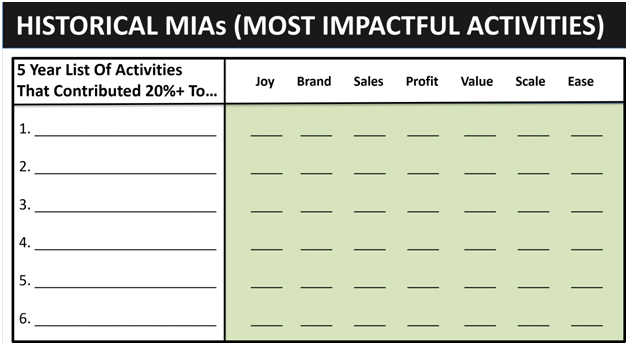
One of the questions that I am most frequently asked is, “How do I grow my business so that I can make more money, but not work myself to death, alienate my family or chase too many squirrels?” We all have a tremendous amount of opportunities screaming for our attention, and we are all very busy – that’s why we are successful enough to be entrepreneurs in the first place.
But, just because we are busy, that doesn’t mean that we are busy doing all the right things.
Perry recently said that most of us as entrepreneurs, when given the choice between doing many of the things that need to be done in our business and rearranging the files in the file cabinet, will rearrange the files in the file cabinet. Then, when all the files are rearranged, we will throw them in the air so they can land on the floor in disarray and we can rearrange them again!
I’m not sure whether that rings true for you, but I think we can all say that there are parts of our business efforts that could be reprioritized to make us more effective and more efficient.
So, here’s a tool that I created to help identify and prioritize the things that contribute the most to your business success. I call the activities that drive growth, revenue, value and profitability your Most Impactful Activities, or “MIAs,” and those that do not, your Least Impactful Activities, or “LIAs.”
Your MIAs are the 20% of your activities that contribute 80% or more of your income. LIAs are everything else that you do, the 80% of stuff you do that contributes 20% or less to your income.
To find out which is which, just take a look at the different profit centers of your business as it sits right now. Use the tool below to list the top 6 in terms of contribution to your revenue and profit…

I like to look back over the previous 5 years of income to do this, but you can choose a shorter horizon if you like. Take a moment now and check your carts, or hopefully better still, your financial statements to identify the profit centers that contribute the most to your income and profits. List the top contributors in the spaces provided on the tool.
This next step is where we add an additional filter. If you only cared about income and profits, you could stop after making the list of the MIAs.
However, I think that knowing your MIAs without any further context doesn’t tell the complete story of what things you should spend your time focused on. I believe that you also need to add some qualitative filters.
That’s what the additional items listed in the shaded section are designed to do. In each of these seven spaces rate on a scale of 1 to 10, how much each of the activities you listed on the left contributes to each of the seven qualitative factors.
For example, let’s say the first MIA is “Consulting” but you really don’t enjoy working with people. Even though consulting contributes a great deal to your business as a profit center, if you don’t love doing it, then chances are pretty good it is not adding to your overall joy and happiness, and ultimately if you keep doing this thing that you don’t enjoy, you will find a way to sabotage it and then that income stream will either stop, or you will damage your brand in some other way by providing inferior service.
That brings us to the second factor, “Brand.” Here we are assessing how much this particular profit center contributes to improving and building your brand. If the activity is good for your brand and you have good customer feedback, then it would be closer to a 10 rating here.
But, if we continue our consulting example, and you don’t like consulting, it’s possible that you are not treating your consulting clients as well as you could or not performing the work as well as you might and that could be creating brand damage. In that case, you might score this factor a 2, 3 or 4.
The “Sales,” “Profit” and “Value” factors are all pretty self-explanatory. If your MIAs are MIAs then they should be contributing substantially to your sales, profit and business value. Completing these factors gives you an idea of which of these receive the biggest benefit from the MIA at hand.
The “Scale” factor is designed to answer the question, “How scalable is this MIA?” If you can do a lot more of this activity and there’s a lot of “blue sky” left to go get more business from this MIA, then write in a number closer to 10. If there’s not a lot of room left on this MIA because you’ve already maxed out your ability to do more of it, then write in a number closer to a 1.
The last factor we’re going to consider is “Ease.” How easy is it to do this particular activity? If it’s super easy, then write in a number closer to 10. If it’s difficult, then write in a number closer to 1.
When you’re done, you’ll have created a list of your Most Impactful Activities, and these are the things you should consider focusing your attention on as you move forward. Any activity that didn’t make it on this list should be carefully examined and, if it is not critical, eliminated from your schedule and your business.
Then, take a look through the qualitative factors and see which activities are engaging and empowering and which ones are like happiness kryptonite. The things that are contributing the most to these 7 factors can be prioritized first for expansion and you can start doing more of those things with the time you used to spend on the 80% of your former activities that only added 20% to your business.
Take a minute now to go through this exercise. When you’re done, you’ll have an action list of things to focus on and you’ll also know why those things are important. Similarly, you’ll identify a whole lot of things that you don’t actually have to do. The result of this exercise can be extremely freeing. Enjoy.




